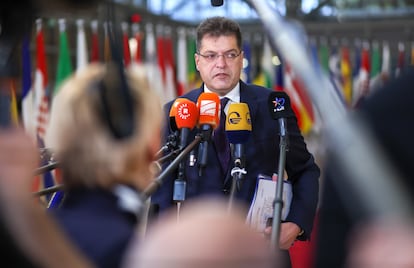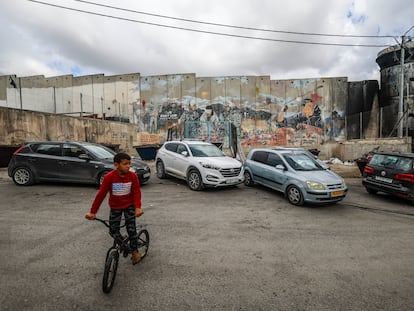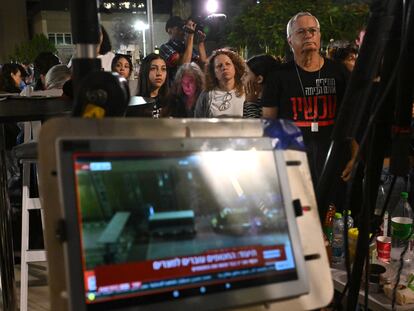EU chief of humanitarian aid: ‘We hope the agreement will allow a substantial surge in aid delivery for Gaza and that it will not be a one-off’
Janez Lenarčič argues that the funds committed to the occupied Palestinian territories should increase given the deterioration of the situation


On the brink of disaster, Gaza’s needs are overwhelming. In anticipation of the outcome of the agreement reached between Israel and Hamas to broker a swap of 50 civilian hostages in exchange for a four-day humanitarian ceasefire and the release of Palestinian prisoners, the EU, the main donor to the Palestinians and Israel’s trading partner, is pressing for water, medicine, food and fuel to reach the Strip as a matter of urgency. The person in charge of the European side of this major aid operation, Janez Lenarčič, Commissioner for Crisis Management and Humanitarian Aid, warns that ensuring basic supplies for the civilian population is an obligation for “all parties in the conflict.” In his office in the European Parliament in Strasbourg, Lenarčič (Ljubljana, 56 years old) details the EU’s response and talks about the future: one where he sees no alternative but the two-state solution — Israel and Palestine.
Question. The situation in Gaza is critical, we are receiving images from local journalists, information from NGOs. But does the EU have first-hand information, are there eyes on the ground?
Answer. Fortunately, we were able to evacuate our EU staff members, but in Gaza we do have humanitarian partners on the ground, and I would really like to underline their heroism because they continue to operate in what is a catastrophic situation and in very difficult conditions in terms of the security aspect. The agency of the NGO for Palestine refugees, the World Food Programme, the ICRC (International Red Cross and Red Crescent Movement). More than 100 members of these organizations have lost their lives in Gaza. In addition, approximately 15,000 Palestinians have been killed, including a very high proportion of women and children. There has been no respite in the intense bombardment of the Strip, there are continuous attacks and fighting around medical facilities, which are protected by international humanitarian law.
Q. We are talking about a siege and an extreme situation for civilians in the Strip.
A. We are talking about a siege which has been only partly mitigated by the resumption of some water and fuel supplies, which are not sufficient for humanitarian needs. So this has to be improved. the UN Security Council finally was able to adopt a resolution that clearly demands extended humanitarian pauses and corridors that would last several days in order to allow for the provision of humanitarian aid. And it clearly specified what these aid should include food, medicines, water, fuel, food. The resolutions of the UN Security Council are part of international law, which was already clearly defined before.
Q. An international law violated in this siege…
A. Yes, it is. You can put it in different ways. It is not in line with international law. This has been clarified by the Security Council for all those who perhaps needed clarification that, yes, all parties at war, and this includes Hamas. And this includes Israeli forces who are obliged to ensure the arrival of supplies and humanitarian aid. We hope the agreement on a pause in hostilities that has just been reached will allow for a substantial surge in humanitarian aid delivery into and within Gaza. And we hope it will not be a one-off.
Q. Apart from this agreement, which remains to be seen how it develops, why is so little aid reaching the Strip?
A. Due to the blockade from Israel, no crossing points can be used from the Israeli side to into Gaza, which means that the only crossing point that can be used is at Rafah [from Egypt]. But even the crossing point has considerable capacity. One day recently, there were about 115 aid trucks that crossed through. If so many trucks were able to cross every day, substantial supplies could be delivered into the Gaza Strip, including Israel’s inspections [of trucks and cargo] that were carried out swiftly. And if this crossing is not enough, another one should be opened. The delivery of essential supplies is an obligation of all parties in the conflict.
Q. Can the EU talk to Israel to get it to speed up its contribution to get the aid through, and is it doing this?
A. We are talking to Israel and there has been positive movement since what happened during the first days, when some supplies were sent back. The quantity of fuel that is being allowed regularly into Gaza is not sufficient yet, for instance. Fuel is very important for the hospitals, for water pumps and desalination plants, for bakeries and for the operations of humanitarian organizations.
Q. The EU is now talking about the day after for Gaza. What will your role be in terms of aid and reconstruction?
A. My responsibility is immediate emergency assistance. So that’s the focus of my efforts, but the European Union is already thinking about further steps. We need a radical change in efforts to get back on track to work towards a political solution to the conflict. That includes steps that should lead us towards a peaceful solution to this long and complex conflict, towards a two-state solution. And there is also a degree of consensus on this.
Q. The situation in Gaza is urgent and terrifying, what is the situation in the West Bank?
A. The humanitarian situation in West Bank is steadily deteriorating, primarily due to the violence by settler extremists and also Israeli security forces. Also, there are restrictions in place that do not allow for the free movement of Palestinians, who have difficulty accessing their jobs or farms. Israel has also canceled the work permits, which represented a big share of income for Palestinians. EU aid is intended to reach both Gaza and the West Bank, although the Strip now has more urgent needs. But in view of the evolving circumstances, both development aid and humanitarian aid committed to the occupied Palestinian territories will have to increase.
Q. The Arab countries and the so-called Global South have accused the EU of having a double standard and of dealing differently with what is happening in Ukraine, due to the Russian invasion, and what is happening in Gaza.
A. Each conflict has its own complexities. The Ukrainian situation is a case of armed aggression by Russian federation against the sovereignty of a peaceful neighbor. What happened on October 7 was a terrorist attack by Hamas, which, according to the EU, is a terrorist organization, which committed the atrocities that cannot by any means be justified by resistance to occupation. When the European Union said Israel has a right to defend itself and to protect its people against terrorism and terrorist attack by Hamas, we also said this right has to be exercised in line with international law.
Q. Yet, many believe that the lives of civilian Palestinians and Israelis or Europeans do not count equally for the EU.
A. I completely disagree with that. The European Union has made that clear in many ways on many occasions, from many sources, that civilian lives have to be protected in any conflict, including this one.
Follow all the international information on Facebook and X, or in our weekly newsletter.
Tu suscripción se está usando en otro dispositivo
¿Quieres añadir otro usuario a tu suscripción?
Si continúas leyendo en este dispositivo, no se podrá leer en el otro.
FlechaTu suscripción se está usando en otro dispositivo y solo puedes acceder a EL PAÍS desde un dispositivo a la vez.
Si quieres compartir tu cuenta, cambia tu suscripción a la modalidad Premium, así podrás añadir otro usuario. Cada uno accederá con su propia cuenta de email, lo que os permitirá personalizar vuestra experiencia en EL PAÍS.
¿Tienes una suscripción de empresa? Accede aquí para contratar más cuentas.
En el caso de no saber quién está usando tu cuenta, te recomendamos cambiar tu contraseña aquí.
Si decides continuar compartiendo tu cuenta, este mensaje se mostrará en tu dispositivo y en el de la otra persona que está usando tu cuenta de forma indefinida, afectando a tu experiencia de lectura. Puedes consultar aquí los términos y condiciones de la suscripción digital.
More information
Últimas noticias
Most viewed
- Sinaloa Cartel war is taking its toll on Los Chapitos
- Oona Chaplin: ‘I told James Cameron that I was living in a treehouse and starting a permaculture project with a friend’
- Reinhard Genzel, Nobel laureate in physics: ‘One-minute videos will never give you the truth’
- Why the price of coffee has skyrocketed: from Brazilian plantations to specialty coffee houses
- Silver prices are going crazy: This is what’s fueling the rally










































